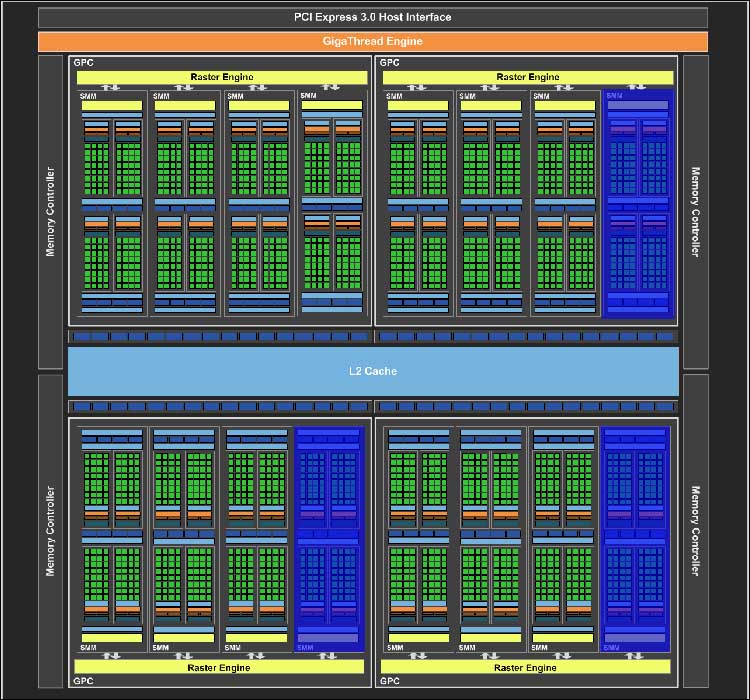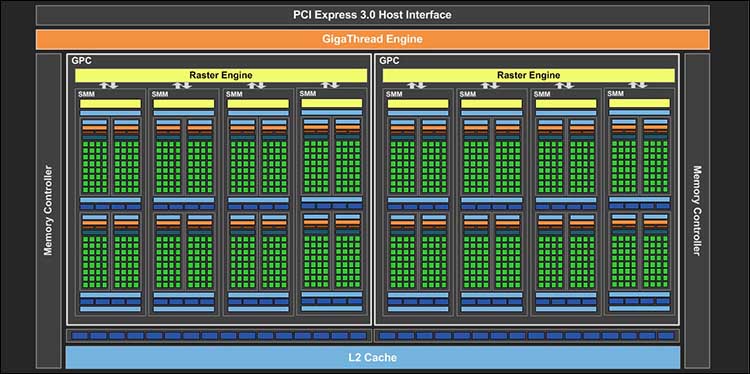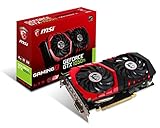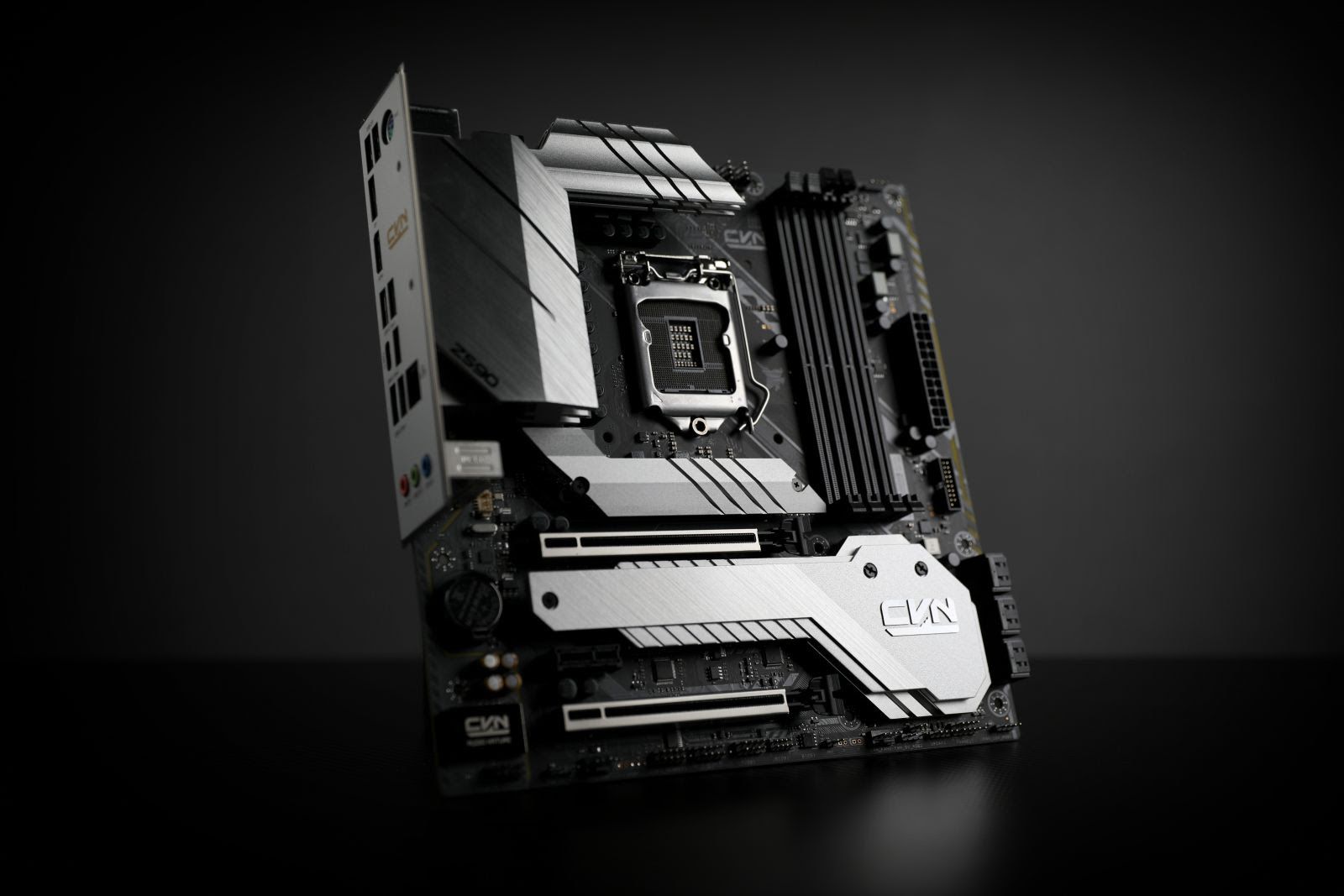For consumers who have never heard of the GeForce GTX 960 and the GPU that powers it, the GM206 can be considered a further cut down version of Maxwell core that powers the GeForce GTX 980 series. To envision this, imagine the GeForce GTX 980’s ‘GM204-200’ core with its 4 Graphic Process Clusters (GPC), with each of these GPCs being made up of four streaming multiprocessor(SMM) ‘blocks’, one 64-bit memory controller and one Rasterizer engine. Each SMM block consists of 32 CUDA cores, 8 Raster Operation Pipelines (ROPs), and 8 Texture Units – plus other low level goodies.
 Now imagine slicing off one SMM in three of the four GPC’s and you have the GeForce 970’s version of the GM204 core – the ‘GM204-400’.
Now imagine slicing off one SMM in three of the four GPC’s and you have the GeForce 970’s version of the GM204 core – the ‘GM204-400’.
 Now imagine taking that selfsame 980 Maxwell core (GM204-200) and the factory cuts off
Now imagine taking that selfsame 980 Maxwell core (GM204-200) and the factory cuts off
two full Graphic Processing Clusters instead of just pairing off a few SMMs. That in a nutshell is what the GM206 is, two Maxwell Graphic Processing Clusters with 8 SMMs and two memory controllers instead of 4 GPCs, 16 SMMs and 4 memory controllers. In other words on paper, the GM206 has approximately half the horsepower of the ‘original’ Maxwell GM204-200, with only two memory controller and only ‘needing’ 2GB of memory instead of 4GB.
In fact it is pretty much safe to say what NVIDIA designers did when designing the GM206 – AKA GeForce GTX 960 series, they took the GM204-200 Maxwell core and cut it in half. However this is being a touch over simplistic as while yes it does indeed have exactly half the ROPS/Texture Units/Cuda Cores of a GeForce 980’s GM204, and while yes its memory bus has also been halved from 256-bit to 128-bit, the GM206 is not simply a GM204 with half of the GPC’s disabled.
Instead NVIDIA did the cutting on the drafting table, and created a new smaller core than the GM204. The end result is not only a new Maxwell core, but one that is more efficient than if they simply used ‘defective’ GM204s with half the cores disabled. In fact the new GM206 weighs in at 56.54% of the GM204-200,with a respectable 2.94 Billion transistors instead of 2.6Billion if it was just a halved GM204-200.
In order to boost performance compared to previous x60 series (which has more CUDA cores and a larger memory bus) NVIDIA has significantly boosted the base and boost clock speeds over what is found on the GM204 counterparts. This is because they had the luxury of having a TDP that is not 50% of the 980 but is closer to 73%. To be precise a reference GM204-200 ‘GeForce 980’ comes with a base clock of 1,126MHz that can be boosted to 1,216Mhz and stay within its 165 watt TDP limit. Compare and contrast to a reference GM206 core which has a base clock of 1,127MHz that can go to 1,178 and has to stay within a 120watt TDP specification. Mix in a much more efficient architecture and on paper this new GM206 is up to 1.4 times more potent in ‘apples to apples’ comparison to previous x60s.
In previous generations the idea of a 128-bit memory bus on a mid-tier card would be a non-starter as the underlying design would not be optimized properly to make use of it. The GM206 on the other hand has been optimized to take full advantage of the smaller pipe-line and at lower resolutions this anemic memory bandwidth of 112.16GB/s should not be an issue. At higher resolutions it may start to cause problems but inexpensive video cards performance levels always suffer at higher resolutions.
This at least was the theory NIVIDA was going on when they designed the GM206 core. Sadly, reality always has the right of way and just like the proverbial Mac truck barreling down a one way street it ran over NIVIDA’s elegant theory. The reality of the matter is the combination of small 128-bit bus and rather small CUDA/TOP/etc count made the 960 rather easy meat for the AMD R9 280X – and 3-series. Since both cards compete in the same $200 price range, the only area a reference GeForce GTX 960 was a clear and concise winner was in the power and noise department. Everywhere else the Tahiti XTL at $200 price point proved to be the better overall value for most consumers. This is where 3rd party manufactures like MSI come into the equation as they have taken that little Maxwell core and drastically improved performance by the simple expedient of overclocking the heck out of the core!











